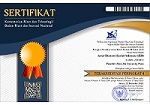Analisis Kebijakan Struktur Modal Berdasarkan Pot dan Tot Persepektif Ekonomi Syariah
Abstract
This study aims to look at the capital structure of firms listed on the JII index (Jakarta Islamic Index), whether to the Packing Order Theory, where the Packing Order Theory or POT is the theory of the company's capital structure in which the order of the company's capital structure is derived from 1). Corporate Internal Funds, 2). Debt and 3). Issuance of Shares. Meanwhile, Trade of Theory or TOT is a balancing between debt benefits and the use of debt will give advantage to the company itself in the form of Tax Shield or reduction of corporate tax burden. The object of this research is 13 companies that entered into JII Index during period december 2013 –November 2018 with 39 data that prossed The data were processed by multiple linear regression with the dependent variable in the form of Leverage Ratio proxied by Debt to Equity Ratio (DER) and Independent variable of Profitability and Liquidity Ratio both proxied in sequence with Return on Assets (ROA) and Currency Ratio (CR), which then analyzed with perspective Islamic economics. The result of research shows that the structure of capital of indexed companies in Jakarta Islamic Index is more likely to use the pattern of capital structure policy based on Packing Order Theory, where the proportion of Debt to Equity Ratio or proportion of debt to capital is not more than 50% in half of the listed companies.
Keywords
Full Text:
PDFReferences
Aji, S. W. (2015). Analisis pengujian pecking order theory melalui keterkaitan faktor-faktor penentu struktur modal terhadap financial leverage: studi kasus pada emiten syariah di Jakarta Islamic Index Periode 2009–2013.
Apriyanto, R., & Surachim, A. (2017). Profitabilitas (ROA) Dipengaruhi Oleh Manajemen Kas. Strategic: Jurnal Pendidikan Manajemen Bisnis, 17(1), 39-45.
Brealey, R. A., Myers, S. C., & Marcus, A. J. (2008). Dasar-dasar manajemen keuangan perusahaan. Jakarta: Erlangga.
Brigham, E. F., & Houston, J. F. (2012). Fundamentals of financial management: Cengage Learning.
Culata, P. R. E., & Gunarsih, T. (2012). Pecking Order Theory and Trade-Off Theory of Capital Structure: Evidence from Indonesian Stock Exchange. The Winners, 13(1), 40-49.
Dewi, U. (2017). Analisis Pengaruh Tingkat Likuiditas Terhadap Efisiensi Dan Kebutuhan Modal Kerja Pada PT Industri Telekomunikasi Indonesia (Persero). Jurnal Ekonomi, Bisnis & Entrepreneurship, 10(2), 91-103.
Dewiningrat, A. I., & Mustanda, I. K. (2018). Pengaruh Likuiditas, Profitabilitas, Pertumbuhan Penjualan, dan Struktur Aset Terhadap Struktur Modal. E-Jurnal Manajemen Universitas Udayana, 7(7).
Horne, J. C. V., & Wachowicz, J. M. (2012). Prinsip-prinsip manajemen keuangan. Jakarta: Salemba Empat.
Jumono, S., Abdurrahman, A., & Amalia, L. (2013). Deteksi Praktis Aplikasi Pot (Pecking Order Theory). Jurnal Ekonomi Universitas Esa Unggul, 4(1), 17894.
Kariyoto. (2014). Buku Kerja Manajemen Keuangan. Malang: UB Press.
Misbach, F. (2014). Pengujian Trade off Theory: Apakah Perusahaan di Indonesia Melakukan Optimalisasi Hutang. Jurnal Media Ekonomi dan Teknologi Informasi, 22(1), 42-55.
Muhammad. (2014). Manajemen Keuangan Syariah analisis Fiqh dan Kontemporer. Yogyakarta UPP STIM YKPN.
Mutamimah, M., & Rita, R. (2009). Keputusan Pendanaan: Pendekatan Trade-Off Theory Dan Pecking Order Theory. Jurnal Ekonomi dan Bisnis, 10(1), 241-249.
Nosita, F. (2018). Struktur Modal Optimal Dan Kecepatan Penyesuaian: Studi Empiris Di Bursa Efek Indonesia. EKUITAS (Jurnal Ekonomi dan Keuangan), 20(3), 305-324.
Oktavina, M., Manalu, S., & Yuniarti, S. (2018). Pecking order and trade-off theory in capital structure analysis of family firms in Indonesia. Jurnal Keuangan dan Perbankan, 22(1), 73-82.
Pontoh, N., Pelleng, F. A., & Mukuan, D. D. (2016). Analisis Profitabilitas Pata PT. Pegadaian (Persero) Kanwil V Manado. JURNAL ADMINISTRASI BISNIS (JAB), 4(4).
Radjamin, I., & Sudana, I. M. (2014). Penerapan pecking order theory dan kaitannya dengan pemilihan struktur modal perusahaan pada sektor manufaktur di negara Indonesia Dan Negara Australia. Jurnal Manajemen Dan Bisnis Indonesia, 1(3), 451-468.
Rasid, A. U. (2018). Analisis Profitabilitas Pada PT. Fast Food Indonesia tbk. Gorontalo Management Research, 1(1), 44-58.
Salim, M. A., & Rodoni, A. (2017). Analisis Capital Structure dalam Keuangan Islam. JURNAL INDO-ISLAMIKA, 7(2), 201-228.
Sanjaya, S., & Rizky, M. F. (2018). Analisis Profitabilitas Dalam Menilai Kinerja Keuangan Pada PT. Taspen (Persero) Medan. KITABAH: Jurnal Akuntansi dan Keuangan Syariah.
Suhardi, S., & Afrizal, A. (2019). BAGAIMANAPECKING-ORDER THEORY MENJELASKAN STRUKTUR PERMODALAN BANK DI INDONESIA? : University Library of Munich, Germany.
Wiagustini, N. L. P., Ramantha, I. W., Sedana, I. B. P., & Rahyuda, H. (2017). Indonesia’s Capital Structure: Pecking Order Theory or Trade-Off Theory. International Journal of Applied Business and Economic Research, 15(16), 119-131.
Wikartika, I., & Fitriyah, Z. (2017). Testing Pecking Order Theory in Jakarta Islamic Index. Manajemen Bisnis-MEBIS, 1(2).
Wikartika, I., & Fitriyah, Z. (2018). Pengujian Trade Off Theory dan Pecking Order Theory di Jakarta Islamic Index. BISMA (Bisnis Dan Manajemen), 10(2), 90.
DOI: http://dx.doi.org/10.21927/jesi.2020.10(2).103-111

This work is licensed under a Creative Commons Attribution-ShareAlike 4.0 International License.












